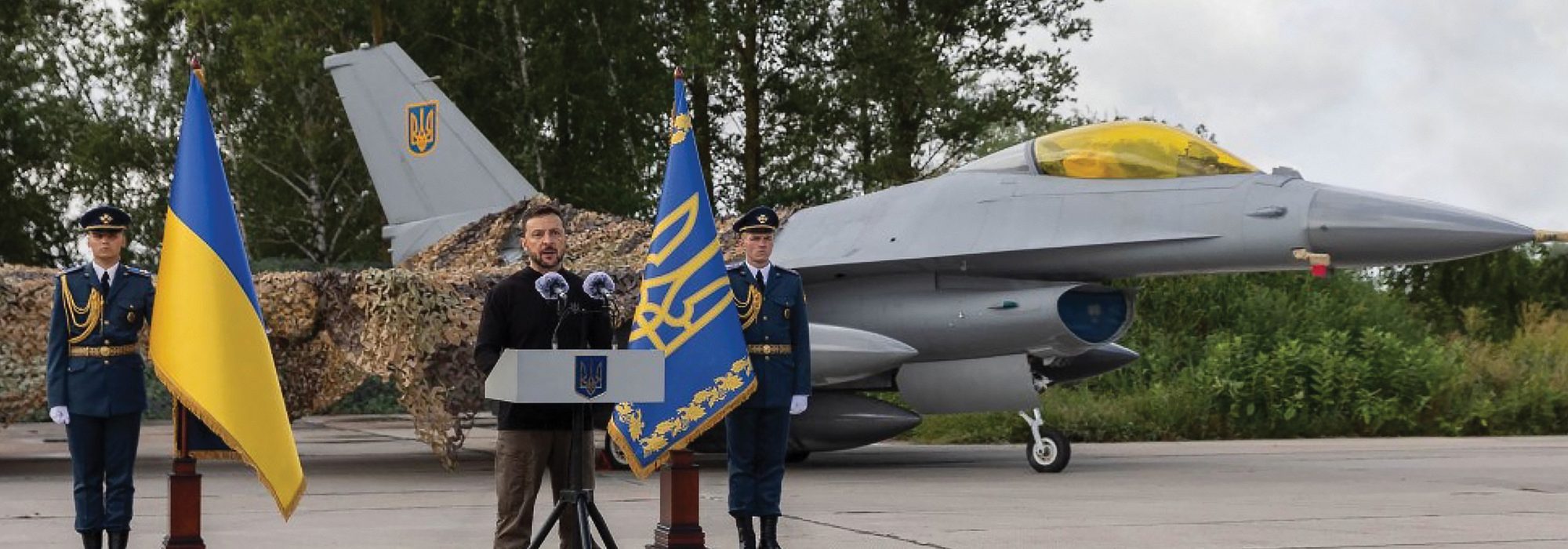Ukraine Unveils Its First F-16 Fighters
By Chris Gordon
Ukraine’s first F-16s were unveiled by Ukrainian President Volodymyr Zelenskyy on Aug. 4, ending a lengthy wait for the Western fighters Kyiv says it needs to defend its airspace from Russia.
“Now we have a new reality in our skies. The F-16s are in Ukraine,” Zelenskyy said in a speech at a ceremony to unveil the country’s first Vipers.
He spoke near two F-16—sporting Ukraine’s blue and yellow trident on their tails—while a pair of F-16s conducted a flyover. But his speech also highlighted the difficulties Ukraine still faces in the skies. The location of the event was not publicly disclosed, lest it come under Russian attack.
“These jets are in our sky and today you see them,” Zelenskyy said in his remarks, according to multiple reports from the ceremony and video of the event posted on social media. “It’s good that they are here and that we can put them to use.”
The venerable, multirole F-16s just celebrated its 50th anniversary, and the jet has been steadily upgraded over the years. Zelenskyy did not say which countries provided Ukraine’s first F-16s or how many are in the country. But the Netherlands and Denmark have led the effort and said they would be first to provide Ukraine with F-16s. Belgium and Norway have also pledged F-16s. All told, allies have promised to give Ukraine more than 60 F-16s, though the process will be gradual.
“Since the beginning of this war, we have been talking with our partners about the need to protect our Ukrainian skies from Russian missiles and Russian aircraft,” Zelenskyy said.
The Biden administration did not sign off on the Europeans’ decision to provide Ukraine with the F-16s until August 2023 amid pressure from allies. The U.S. is not proving its own F-16s but must agree to the transfer of U.S.-made weapons.
There are a host of other unanswered questions, including how the planes will be maintained, the full range of munitions that will be used to arm them, and what missions they will perform.
Washington has put stipulations on how Ukraine can use the advanced weapons it has already provided. And it remains to be seen whether the U.S. and its allies will authorize Ukraine to use the aircraft to engage enemy aircraft over Russia or target sites inside Russia with air-to-surface weapons.
“This decision is probably a difficult one for our partners, as they are always afraid of unnecessary escalation,” Zelenskyy said.
The nonstealthy, fourth-generation F-16 has its limitations even in taking on a narrow set of missions, such as protecting Ukraine skies. It is vulnerable to Russia’s advanced surface-to-air missiles. Ukraine also needs to take precautions so the aircraft are not destroyed on the ground. U.S. officials and airpower experts have cautioned that F-16s will not turn the tide immediately.
“It’s not going to be the … golden bullet, that all of a sudden, they have F-16s, and now they’re going to go out and gain air superiority,” U.S. Air Forces in Europe commander Gen. James B. Hecker said recently. “We started the clock, and I think that’s a good start.”
The New York Times reported Aug. 4 that roughly half a dozen pilots, flying about the same number of jets, were practicing in “uncontested” Ukrainian airspace.
“Since the beginning of this war, we have been talking with our partners about the need to protect our Ukrainian skies from Russian missiles and Russian aircraft,” Zelenskyy said. “We made it happen. I am proud of our guys who are mastering these aircraft and have already started using them for our country.”
The jets on display Aug. 4 were mounted with what appeared to be AIM-120 AMRAAM radar-guided medium-range, air-to-air missiles and AIM-9 Sidewinder infrared short-range air-to-air missiles.
The capabilities of those weapons vary depending on the variant. The jets in Ukraine appeared to be equipped with the AIM-9L model. They are able to hone in on their target from higher angles—so called off boresight capability—compared to the oldest Sidewinders. But the U.S. Air Force has moved on to the new, advanced AIM-9X, with lock-after-launch, better maneuverability, and enhanced countermeasures.
It was not immediately clear which variant of AMRAAM—or its inert training model, the CATM-120—was mounted on the jets. Ukraine is unlikely to receive the newest models of AMRAAMs. Air & Space Forces Magazine previously reported that AMRAAMs were being considered for Ukraine’s F-16s.
Ukraine’s F-16s will likely employ HARM anti-radiation missiles, JDAM guided bombs, and Small Diameter Bombs, which the U.S. has already given to Ukraine for use on its existing MiG and Sukhoi jets.
“Now they’re going to have the opportunity to actually drop them off of an airplane that they were designed to come off of, which will give them more capability to change the targets in flight and things like that,” Hecker said recently. “That’s going to increase the capability.”
The U.S. will work with its allies to provide Ukraine’s F-16s with “precision munitions designed to enhance Ukraine’s air combat capabilities to defend its airspace and carry out effective air-to-ground operations,” a Pentagon spokesperson told Air & Space Forces Magazine in late July. Some of the weapons will come directly from U.S. and allied stocks and some will be procured from defense companies.
“Our combat aviation will bring us closer to victory,” Zelenskyy said.
